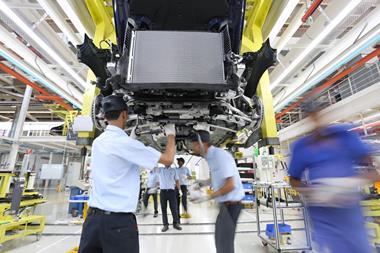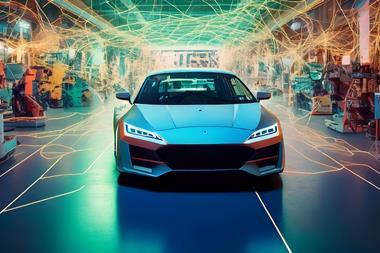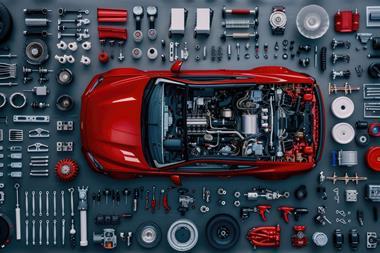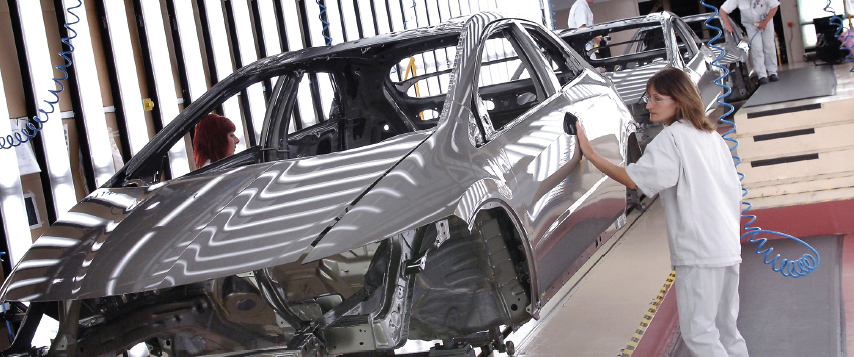
The success of Honda’s Civic and CR-V models has been nothing short of phenomenal, and production at its UK manufacturing facility has reached capacity 12 months ahead of forecasts. AMS talks to chief engineer at the Swindon plant, Mike Godfrey, to find out what processes are in place to ensure production runs smoothly
Honda in the UK has become a victim of its own success. Demand for Civic and CR-V models manufactured at its Swindon plant is such that the factory has reached its maximum output of 250,000 vehicles 12 months ahead of expectations.
Honda Manufacturing UK (HUM) was established in 1985 initially as an engine plant. Accord production was started in 1992 and production of the Civic model started in 1994, but in October 2005, the range was boosted with the introduction of the latest version. In September 2007, the millionth Civic unit rolled off the UK production line. In the months between March 2006 and May 2007, the daily production rate has ramped up from the equivalent of 150,000 to 250,000 units a year.
Mike Godfrey, Senior Manager and Chief Engineer at the Swindon plant, concedes that to build more cars, Honda would have to build a third line – for which there is no room. “Swindon is basically producing maximum output in terms of finished cars and both lines are running at full production on two shifts, and sometimes three, to get the full output of Civics and CRVs to European customers.
The HUM site at South Marston, UK is a £1.33 billion (about $2.6 billion), fully integrated car manufacturing facility producing totally finished cars ready for the road. The processes on-site include engine casting and assembly, the pressing of body panel, body assembly, painting, final vehicle assembly and test track sign-off. Honda was founded in Japan in 1948 but now has 120 manufacturing facilities in 29 countries around the world, employing 131,600 ‘associates’. Of the worldwide employee count, 4,700 work at the South Marston facilities in Swindon, home to HUM, HRE (Honda Research Europe), EGE (Honda Engineering) and SDC (the logistics supply division).
The South Marston sites covers 1.5million square metres (or 370 acres) and was formerly an airfield and aircraft production facility where, during World War II, Spitfi re aircraft, among others, were produced by Vickers Aviation. Honda uses one of the airfield’s original two runways today as the on-site test track.
Cars produced at Swindon are mostly exported
Honda bought the South Marston site in 1985 and initially set up a Pre-Delivery Inspection facility there for the cars built by Rover at Longbridge and Oxford but were badged as Hondas. Honda then opened an engine assembly facility onsite making power units for Honda and Rover cars. Car Plant 1 came on stream in 1992 and in 2001, Car Plant 2 was added to the South Marston site. The site currently produces around 190,000 cars a year, 75 per cent of which are exported. Honda produces engines at the rate of 180,000 units a year at Swindon. In addition to petrol engines, the company has just added production of its latest high-tech diesel engine. Some engines produced at Swindon are exported to Turkey, where Honda manufactures a fourdoor version of the Civic for the Eastern European and Chinese markets. In theory, the current site could produce up to 250,000 cars annually if a four-shift system was adopted but HUM says there are currently no plans for this to happen. HUM operates for 237 working days a year over a fi ve-day week with associates working 37 hours per week. The facilities shut down completely for the annual summer holidays and at Christmas.
Production is HUMming at Swindon!
HUM is the UK’s fourth largest passenger car plant with 870 cars being manufactured daily. The site is divided into three manufacturing units.
* Current Daily Production: 885 cars per day
* No.1 line (CR-V & Civic fi ve-door): 605 units/day (2 shifts)
* No.2 line (Civic fi ve-door & Civic three-door): 280 units/day (2 shifts)
* Total engines produced in 2006: 147,000 units
* Seventy five per cent of the cars produced at Honda in Swindon are exported
The third on-site facility is the engine plant that, in 2006, produced 147,000 units on a two-shift system. Latest production innovations on site include a new manufacturing system in Plant 2 where welding robots automatically go to the jigs holding the panels to be welded together rather than the conventional system where panels are transported to the assembly jigs. The robots automatically change their own welding heads depending on which panels they are joining. This plant uses 142 robots to 74 associates.
On the cutting edge of technology
The engine plant now has its own high-precision aluminium smelters where 25 tonnes of aluminium ingots are used daily to produce, by die-cast and injection moulding processes, cylinder heads and cylinder blocks. A cylinder block is produced every 110 seconds and two cylinder heads are produced in pairs every two minutes. This plant has only recently started producing and machining cylinder heads for Honda’s award-winning new diesel engine. Until now, components for this advanced engine have been brought from Japan to Swindon for final assembly.
The Swindon engine plant is the only manufacturing facility in the UK where petrol and diesel engines are assembled on the same production lines. It produces 300 diesel and 380 petrol engines daily. At the end of the engine line there are three dynometers where around one engine in a thousand, depending on what manufacturing or specification changes have taken place in the production process, is run up to test performance and durability.
These tests can run from one to 400 hours per engine covering up to 8,000 different operating cycles, from stop-start through to running at prolonged maximum speeds. At the end of the tests the engines are destroyed and not fitted to production vehicles. To re-cycle the energy generated during the tests each ‘dyno’ is linked to a generator that provides electricity to top up the power used by the South Marston facilities.

Both lines are running at full production
“This means we’re producing 250,000 cars a year, with Line One producing about 612 cars a day and Line Two about 570 cars,” he explains. Even if the plant could build more cars, it would also have to consider the ability of suppliers (it has 200 Tier One suppliers) to keep pace and provide the extra volumes. The only thing we can do is to look at how can we become more efficient by bringing increased submanufacture and component manufacture, such as plastic parts, in-house.
“For example, diesel engines are becoming more popular and we need to ensure that in the future we can be almost completely self-reliant as far as their manufacture is concerned. We also need to expand our capability to manufacture components both at Swindon and locally as well, to decrease our reliance on Japan,” he says. “Fortunately, we do have the space and resources to increase our diesel engine component manufacturing – there are planning applications in the pipeline. But as far as building more cars is concerned, we would need a third line and we just don’t have the space. We always anticipated that we would get very close to our capacity but what we didn’t realise was just how quickly we would get there, following the introduction of the new Civic in 2005/6 and the CRV, especially the latter,” Godfrey tells AMS. Forty per cent of Swindon production is sold in the UK and in 2008, the sales target is between 108,000 and 109,000 units. However, the carmaker says the European market is flat, though it believes that Russia offers ‘exciting’ potential for growth.
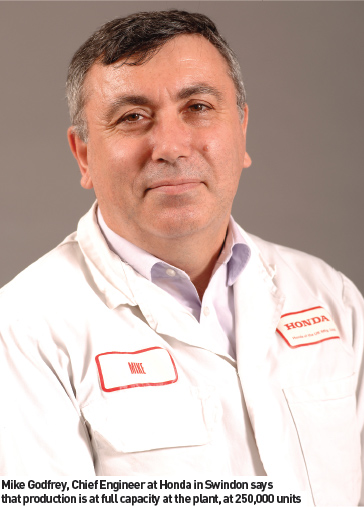 “Overtime should be the exception, not the rule”
“Overtime should be the exception, not the rule”
How has the carmaker coped with the increased demand? “In eight months, we’ve gone from a 190,000-a-year car capability, with 4,200 staff to 250,000 with an extra 800 staff, and so we have to get stability back into the process,” Godfrey tells AMS. He reveals that some suppliers to Swindon may have had to bring in some weekend work to keep up.
“That’s not an ideal scenario and we need to bring back a lot of supplier activity into core hours, as opposed to overtime hours. Overtime should be the exception, and not the standard,” he adds. “But we will get back this stability by working with suppliers and if they need extra investment then we will work with that as well, upfront or through the part price of what we buy.”
Over the past 20 years, Honda has invested nearly $3 billion in the Swindon operation and has recently committed $40 million to new spray paint technology for plastic parts, aimed at reducing costs and solvent emissions. “We’re looking at reducing the number of robots needed for that process but the key element, from the point of view of Honda’s environmental policy, is to reduce air emissions, especially the solvent or VOCs associated with the painting process,” Godfrey tells AMS. “Normally, all the spray and solvent emissions are focused and put through an incinerator; sometimes these air emissions don’t have a high enough solvent concentration, so you have to burn a lot of gas to burn the solvent off.”
“So we have developed [with Durr] a system that re-circulates the solvents, with the robots safely operating in a high-VOC atmosphere, waiting until the VOCs are sufficiently concentrated before putting them through the incinerator so that it burns without using gas. It’s ‘selffunding’ system in terms of energy, as the heat generated is in turn used to heat incoming air. Once you have it up and running, it is a self-perpetuating system.
Although the technique is not unique in the industry, it is unique within Honda’s global operations. “It is a means of reducing solvent emissions by using them effectively as a fuel for the incinerator,” Godfrey explains. He adds that the new process is slated to be operational in the early part of this year. This will allow the Swindon plant to reduce gas consumption by about 90 per cent for that particular process. “Europe is ahead of Japan on this issue and engineers from Honda in Japan have visited Swindon to see the process in action,” he adds.
Global platforms for new model introductions
The new Civic was the first Honda to be ‘launched’ by Swindon but how much autonomy does the plant have? Godfrey says that a lot of the technology comes from Honda in Japan – “If you visit any Honda plant, you will see line layouts in the paint and welding areas that are almost identical. It’s a global standard that Honda has that is fundamentally related to new model introductions.” He says that this allows the design engineers to design a car to suit the welding and painting processes that are universal. But in the plastic painting process, for example, or engine machining or assembly, the Swindon plant has a lot of autonomy. “We are free, to an extent, as long as the key measures of cost, quality and delivery are met, and that we source equipment for manufacturing where we think it’s appropriate,” Godfrey adds. “Maybe Japan will have the best solution. If they do, we’ll use them, but if not, we will source from elsewhere. If you buy from [Honda in] Japan, you could benefit from its global purchasing power but then you have to think about the service parts, breakdown issues, and the distance involved which are all concerns, in addition to the cost factor.”
Although the new Civic has captured the public’s imagination, it did not roll off the production line without a few challenges. The rear window has a unique design with its built-in spoiler, a key aspect of its deliberately sporty design. Godfrey explains the manufacturing complexities involved: “We wanted to do away with the wash wiper. The designers worked extremely hard to get the optimum angle for the airflow, to get rid of dirt and water with the two-piece system, the bottom half of which is made of polycarbonate.”
The rear window has a unique design with its built-in spoiler, a key aspect of its deliberately sporty design. Godfrey explains the manufacturing complexities involved: “We wanted to do away with the wash wiper. The designers worked extremely hard to get the optimum angle for the airflow, to get rid of dirt and water with the two-piece system, the bottom half of which is made of polycarbonate.”
Working in tandem with suppliers
The rear window was designed in Japan and according to Godfrey, “Our first task was to find a supplier [Freeglass in Germany] of that type of product and then work with them for the tooling and moulding processes as well as the coating process required to protect the surface. It was very much a partnership with the supplier. They have the tooling technology and we have the know-how for the sort of overspray process required for the polycarbonate moulding.”
He says that it was an “interesting challenge but there was no compromise”. To date, there have been no issues from the public regarding the rear screen but, says Godfrey, “It was an immense technical challenge for us and the supplier, who had previously not produced anything like it. It involved a lot of hard work from all parties concerned and we got it ready for production on a just-in-time basis. Meeting that challenge made us confident that we would be able to increase production from 190,000 units a year at Swindon to 250,000 units.
Godfrey says that the next level of efficiency at the Swindon plant focuses on parts. “We’re doubling the capacity for painting plastic components, whether they’re bumpers or smaller plastic parts. We also hope to manufacture more of the diesel engine parts than we do now,” he tells AMS.
“Honda’s strength is its engines and we already manufacture main castings, such as the block and the head but we buy in [from within Honda] the majority of parts that hang on to the outside of the engine, including the crankshaft. “There is a logic that says that if it’s cost effective – and that is something that we are analysing – we can, within cost and delivery and control issues, look at the manufacture of those type of internal engine parts,” Godfrey adds.
For the moment though, Honda in Swindon is working hard to get the models off the line that the public demands.































